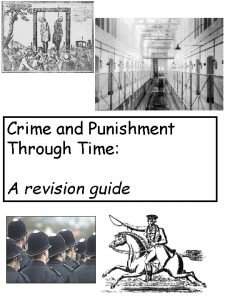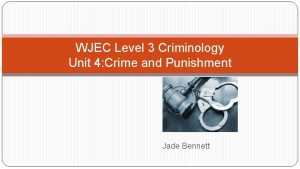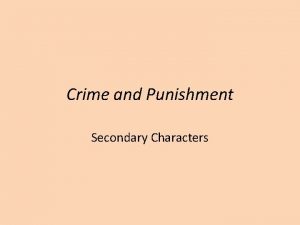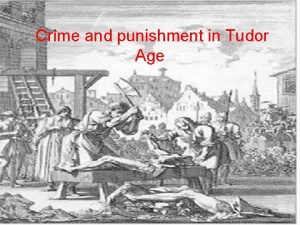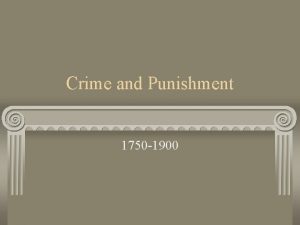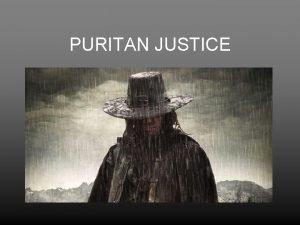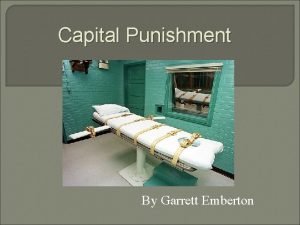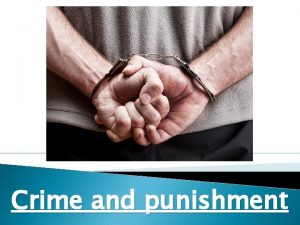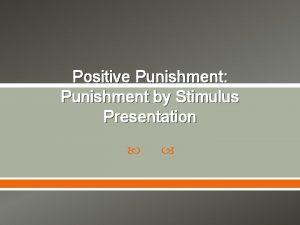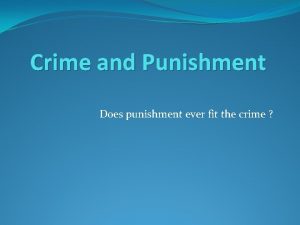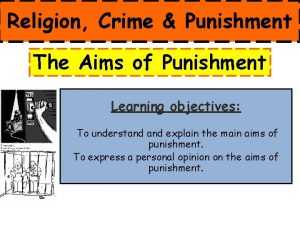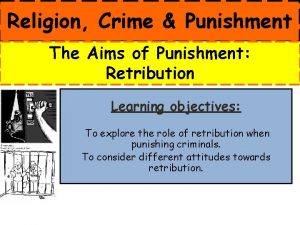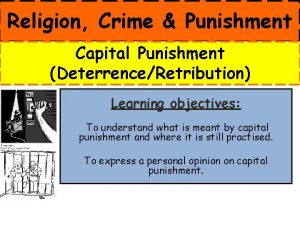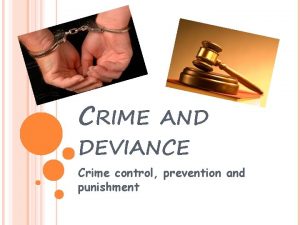Crime and Punishment Through Time A revision guide






















- Slides: 22

Crime and Punishment Through Time: A revision guide

1450 -1750: Medieval Church courts Manor courts Royal courts Dealt with priests, monks and nuns and those who refused to pay a tenth of their income to the church Dealt with ordinary villagers in the countryside and made them keep to the rules set by the ordinary landowners. The most likely to be fined and punished were unfree farmers called villeins. Though the court did protect them from being made to do too much work or being fined too much. The Royal courts dealt with all serious crimes and all types of people. Divided according to their seriousness: - Murder, Arson, Rape, Treason, Robbery: Punished by hanging - Assault, Selling goods at wrong prices etc: usually punished by fines of money Limits to justice: Only free men could appear in the Royal Courts. Women could only go to court to accuse someone who had: (a) Murdered her husband (but only if he had died in her arms), (b) attacked her and this led to the loss of an unborn child or (c) Raped her Prisons – It was not until 1576 that local judges were required to build houses of correction in which beggars could be kept. Medieval prisons were mostly for holding people awaiting trial. Prevention of crimes: - Making a group of 10 people (a tithing) responsible for each other’s actions. If a crime was committed they had to hunt for the criminal (Hue and Cry) - Deterring people by threat of punishment - Church teachings about right and wrong Reasons for medieval crime waves: Rising unemployment, rising prices, weak government and corrupt judges In court, two methods to decide guilt of accused: 1) Witness of neighbours: Could people swear they had a past of good behaviour? 2) Trial by jury: A group of local people looked at the evidence, listened to witnesses and discussed the character of the person. There was no police force. By 1400, landowners were appointed as Justices of the Peace to hold local courts at least four times a year to deal with less serious offences

1450 -1750 BEFORE: Changes in the economy in the late 14 th and 15 th century had increased the numbers of people wandering and looking for work. SO: Changes in society led to a moral panic with beggars (often healthy) being thought of as criminals – and punished. Reasons why the numbers of beggars increased during the 16 th century: Reasons why begging was treated harshly and as a crime: - Closure of monasteries took away support for the poor -Population increase put pressure on jobs and food - Landowners kept sheep instead of growing crops. This needed fewer workers -The cost of supporting beggars was resented by communities they ended it up in - Poor people were more likely to turn to other crimes such as theft - Large numbers of travelling beggars seemed to be a threat to people who felt they should know their place within a community. LAWS/CHANGES 1531: A law passed by parliament separated the ‘Deserving Poor’ (sick or injured beggars worthy of help) from ‘Sturdy Beggars’ (those considered lazy). All beggars were to be classed as either deserving a licence or punished. Justices of the Peace put the new law into effect. 1547 VAGRANCY ACT: Forced beggars to work. It also ordered they should be whipped and branded. This law, though, was impossible to enforce and was repealed (abolished), but showed how worried people were. Despite the laws against begging, it was impossible to stop because it was brought on by wider social causes (e. g. population growth)

1450 -1750: What beliefs affected attitudes towards crime and punishment? Increased unemployment led to beggars wandering from town to town Causes of different types of crime Changes in religious beliefs led some to refuse to follow official religious beliefs The improved quality of roads led to more highwaymen Attitudes and beliefs Divine right: It was believed that God gave power to kings and queens Hierarchy: There was a strong belief that society had strict ordering with some groups above or below others in terms of power, wealth and rights Property: The richest people owned most property and only wealthy people were represented in parliament, were laws were made. What challenged this system? • Increased population: In 1450 the population of England was 2 million. By 1750 it was 7 million. • Increased urban growth and unemployment: Growing towns were harder to control. • Crimes against property: Most crimes committed by the poor were crimes against property, not crimes against the person. Landowners were rich law makers. Also many landowners restricted access to their land for hunting etc. Law enforcement case study: JONATHON WILD He was a Thief-taker - someone who makes a living from tracking down criminals and collecting rewards. Wild was a former criminal who set up innocent victims, tricked them into crime for the rewards. He was eventually found out and hanged. Afterwards there was a surge in robberies and other crimes in London. This was because Wild controlled many of the criminal gangs when he was alive. Yet people still thought it was too expensive for a police force, if one was set up it would affect their freedoms and that the answer lay in more bloodier punishments to control crime.

1450 -1750: How did rulers meet the challenges they faced? The Bloody Code Historians use this phrase to describe how the number of crimes carrying the death penalty rose significantly in this period (including stealing sheep, smuggling and damaging trees). Transportation also began in this period. Punishments varied according to person’s social Authorities reacted by: group. Commoners were hanged, drawn and quartered. Nobles were beheaded. Until the 18 th century, any first-time offender who claimed benefit of clergy Criminalising beggars (were able to read a passage of the bible) was often acquited. The use of fear: authorities aim was a mixture of retribution (punishment) and deterrence (preventing crime), With no real prison system, the punishment was either removing them (execution), fining them , hurting or humiliating them in stocks or pillory). Poaching – People did this often out of necessity because of unmployment/money. Some also did this as a result of landowners closing off land. Law makers made it punishable by death. Smuggling – The response of high taxes meant goods were often smuggled in. Most ordinary people didn’t see it as a serious crime because they could benefit. Law makers made it punishable by death. Why rulers felt under threat and how they reacted Political changes between 1485 and 1750 caused rulers to feel under threat. This led to an increase in accusations of treason (Guy Fawkes) Earlier harsh punishments – designed to crush opposition to royal power (hung, drawn and quartering) – were increasingly used in this period. Lessening of political tension after 1750 reduced the use of such punishments

1750 -1900 Overview The 4 major changes in this period were: 1) By 1850 the Bloody Code had been swept away due to changing attitudes to punishment. 2) Prison sentences became the most common punishment. 3) Professional police forces were set up. Rising crime and the fear of it was a common factor at this time. 4) The government became increasingly involved in matters through intervention and greater wealth Huge growth in towns led to increased street crime and burglary Many immigrants moved into areas of terrible poverty with many turning to crime Changes in society Growth in alcoholism, disorder and riots The increased movement of the population meant it was harder to know and keep track of people Summary -Massive economic and social changes took place after 1750. This led to an increase in crime and disorder - Many of these crimes were crimes against poverty and were committed by poor people struggling to survive. - The violent state of the worst slums meant that crimes against people increased too.

1750 -1900 How did governments respond to threats to authority? There were many challenges to authority including: - The French Revolution encouraged some people to hope for similar change here - Many people wanted more moderate demands such as the right to vote, right to strike etc. - With no police until 1829, soldiers were used to put down uprisings The government often dealt with it by using soldiers – this led to many deaths and unpopularity against them. They also used laws to control people who protested at how Britain was being run. This led to many people who demanded reform were treated as criminals. Reforms after 1850 meant that demands for change were no longer treated as crimes. Protest case study: Tolpuddle Martyrs In 1833, a peaceful group of Dorset farm workers from the village of Tolpuddle formed a trade union to try and stop their wages going down. They did not act violently but the local rich farmers and the government feared they might lose control of their workers. The authorities reacted by using a navy law from years before about breaking silence at meetings to arrest and transport them to Australia for seven years. After huge protests the Tolpuddle Martyrs were eventually released in 1836. This case is a landmark as it shows how the authorities backed down. Transportation: The deporting of convicted criminals. The sentence of transportation could be a set number of years or for life. It completely removed the criminal from society By 1780 s, many prisons were overcrowded. Petty crimes were also increasing in many towns and cities This was seen as a less humane solution to execution when dealing with criminals who damaged or stole property It ended because of cost and that Australia was becoming independent and didn’t want our criminals

1750 -1900 From prevention to detection: The Police Before the Police: Parish constables dealt with minor disorders, beggars and petty criminals. Troops could be used to put down riots or rebellions. Why the change? Constables did not have much chance of success in cities, especially London, where the crowded streets and houses provided ideal shelter for criminals. The system of law and order had been the same for centuries and couldn't cope with growing towns. Timeline of change 1749 London magistrates (lawyers) John and Henry Fielding: • Set up a civilian horse patrol to stop highwaymen. • Introduced Bow Street runners, a team of thief-takers who patrolled the streets of London in the evening. • Published ‘Hue and Cry’ newspaper that contained details of crimes, criminals and stolen property. This helped pass on information about criminal activities. 1829 Sir Robert Peel (Home secretary) set up the Metropolitan police force in London. It had 3200 men. He was able to set up a force because: - Government had more money from taxes to spend. - People feared protests - Increased crime and the fear of it Attitudes to the police At first the police (peelers) got a lot of bad press including: there was not enough of them, and they did not have the right equipment (truncheons) to deal with criminals many of who were armed. But by 1900 attitudes had changed. Improved pay and training meant that the police had developed a reputation for honesty. Targeting uniformed patrols in high crime areas helped to reduce street crimes and disorder. The use of photographs and fingerprints assisted crime detection.

1750 -1900 How successful were 19 th-century prison reformers? 3 major changes occurred in the way prisons were run: - Imprisonment became the normal method of punishing criminals - Reforming prisoners became the aim of punishment (Bloody Code had not worked) - The huge increase in prisoners led to the government taking over and reforming the whole prison system (Rising crime at start of 1900 s) Retribution To punish people for doing wrong Deterrence To discourage others from doing it Why prisons? Restitution To work and payback society Removal To keep them away from others Rehabilitation / reform To change a person for the better Reformers John Howard: He toured prisons in Britain and wrote a book highlighting bad conditions and other issues. It highlighted problems in the system but reforms did not begin until after his death. Sir Robert Peel (Home Secretary): He introduced acts that changed prisons including inspections of prisons, visits by doctors and basic education. Oversaw huge new prison building scheme. He also reduced the number of death penalty offences. Elizabeth Fry: Fry introduced changes in Newgate women's prison and then in others including female warders, schools for women and children and clothing/furniture. Prisons in the late 19 th century were a compromise between rehabilitation and retribution. It also showed, just like the police, that the government got more involved in British society.

1900 to present day Changes in policing and combating crime since 1900 The impact of technology on fighting crime: -Fingerprinting: The Scotland yard fingerprint department was set up in 1901. In 1995 a computer system was launched allowed all English and Welsh police forces to compare fingerprints. - Radios: Modern communications makes it easier to report issues and call for back up. - Computers: Sorting information, finding patterns and matching evidence saves a huge amount of police time. - DNA evidence: Can be used to identify victims and criminals from tiny quantities of hair, blood and skin. - Cars and motorbikes: Greater mobility means police can get to crime scenes quicker. - CCTV: Can be used to monitor peoples behaviour in real time or recorded. CONTINUITY: Modern Neighbourhood Watch schemes involves local people in crime prevention. This is similar to the 15 h century, which made local communities responsible for the behaviour of their neighbours and reporting crime. The difference is that the modem scheme is completely voluntary. Challenges facing policing in the 21 st century are: • Terrorism (IRA an Al-Qaeda): London suicide bombings by Al Qaeda. (muslim terrorists) The IRA had launched attacks on Britain since the 60 s. They wanted Northern Ireland to be independent from Britain and join Ireland international fraud * International fraud (on computers, hacking computers etc). Changing definitions of crime Since 1900 a number of new definitions of crime have led to the punishment of different groups of people who would not have been punished before including conscientious objectors (people who refused to fight in wars) and people who drive badly (due to the increase in motorised transport).

1900 to present day Traffic Crime. Speeding, dangerous driving and using your mobile phone while driving are all crimes today were not before the 20 th century. Race crime. Race relations act (1968) made it illegal to refuse housing and employment to a person on the grounds of race. Before this, racist motivation of crimes would not have been considered seriously. Changing attitudes towards what constitutes crime Conscientious objection. People who refused to go to war could be courtmartialled and receive sentences up to 2 years imprisonment. Cowardice in the face of the enemy has always been crime. Yet modern war (WWI etc) meant you were executed. Domestic violence. Violence in the home has often been ignored unless the crime involved murder or serious assault. Crime trends since 1900 - Crime has increased since 1900 - The prison population has increased since 1900 - However, the percentage of women in prison has fallen since 1900 - Since 1992 the level of crime has fallen - Some newspapers, though, give the impression that the level of crime is increasing

1900 to present day Why was capital punishment abolished? If you murder someone you deserve to die It gives justice to the victims families Capital punishment does not deter murderers What if the wrong person is convicted by mistake? The abolition of capital punishment in the UK was not a sudden decision. Due to arguments like those above, it was gradual. In 1908 people under 16 were no longer hanged, but it took until 1933 for under 18 s and 1969 until it was abolished for murder. Jack Straw (Home Secretary) finally abolished the death penalty in the UK in 1998! Controversial executions Timothy Evans, 1950 Hanged for killing his wife and baby. Later evidence revealed that another person living in the same flats had really committed the murders. Evans was pardoned in 1966. Derek Bentley, 1953 19 year old Bentley was found guilty of armed robbery in which a policeman was shot dead by Bentleys partner Craig. Because Craig was 16 he was not executed (under 18). Bentley also had learning difficulties. He was pardoned in 1998. Changes to prisons. They had more functions such as officers trained to re-educate prisoners. ‘Open’ prisons for less dangerous criminals. Some prisoners on probation instead of straight inside. Ruth Ellis, 1955 Suffered violent abuse by her boyfriend who she eventually murdered. Jury had to sentence to death as no other alternative. Last woman to be hanged. Children and the prison system. From 1908 separate prisons were established for children. Recently there has been rising levels of violence in youth offending prisons and re-offending rates have been high. But governments remain under pressure to be seen ‘doing something’ about crime. Changing punishments in the twentieth century Women and prisons. Recent years has seen a dramatic rise in women sent to prison. They have always committed much less crime by men. Some women's prisons now allow them to spend some time with their children. Alternatives to prison. Community sentences are now often used. Examples include drug or alcohol treatments, community projects (service) and charity work. Electronic tagging and ASBO’s are other changes.

1900 to present day How new are ‘new crimes’? Possible new crimes and their links to older forms of crime OLD NEW Selling of poor girls into prostitution was a problem in 19 th century cities. People trafficking. Many people from less economically developed countries are illegally bought to the UK and work in prostitution or for low wages. In the 18 th century organised criminal gangs smuggled goods. Drug smuggling is a multi-million pound industry. Impersonating another person to steal money is an old crime, as is tricking money out of a person. Computer crime is often used to commit fraud. Street robbery and other forms of street crime have been a problem for centuries. Street crime and anti-social behaviour causes great concern in many towns and cities. • There are totally new crimes due to new technology such as ‘speeding’. • Changing attitudes can cause new definitions of crime. An example is driving while using a mobile phone, since people have realised over time that it leads to accidents.

Crime and punishment from Roman Britain to 1450 Overview - Even though societies changed in this time, attitudes and ways to deal with crime remained fairly consistent for most of this period. - The beliefs and attitudes about crime and punishment mainly reflected those of the more powerful groups and classes. - Individuals were usually held to be totally responsible for their criminal actions, no matter what their circumstances were (e. g. poor/jobless etc). - The key aims of punishment remained fairly consistent. They were Deterrence: deliberately harsh punishments used to stop others committing them, and Revenge: wanting criminals to suffer for their actions. Roman Britain • Roman society meant different people had power over others. At one end were wealthy families who owned property and slaves and at the bottom were the slaves themselves. • There was no proper police force in Roman Britain. Major crimes were dealt with by the governor and minor cases in small local courts. Yet if someone felt they had been robbed, they had to take the suspect to the local centurion who then decide, d on the evidence provided, whether the case should be tried. • The most serious crimes included Rebellion (if a province like Britain rebelled or plotted against the emperor they would have severe and gruesome punishments inflicted on them). Also Religious non-conformity (while people who were conquered by the Romans were allowed to continue worshipping their own gods, they also had to worship the emperor as part of the civic religion. When Christians refused to do this, they were severely punished). • Punishments were different if you were a man, woman, citizen or slave. Crimes Punishments Minor crimes (e. g. petty theft) -Flogging (whipped) -Beating -Financial penalties Major crimes (e. g. mugging) -Amputation of limbs More serious crimes (murder, arson and slander) -Execution by various methods -Exile (Only wealthy people could be sent away from a region) Most serious crimes (such as refusing to accept the authority of the emperor) -Execution by crucifixion or being thrown to the lions -Being forced to become a gladiator

Crime and punishment from Roman Britain to 1450 Anglo Saxons - Anglo-Saxon law was more localised than Roman Law as Britain was split up into different kingdoms for much of the period. - The role of the local community grew and the importance of family was key. Loyalty to family was highly prized which had a huge impact on crime and punishment as family groups stuck together in support of their kin. Blood feuds meant the victim or the victims family had the right to take revenge on the person who had done them harm – even by killing them or a person in their family. Sometimes this led to long running family feuds and violence. - The role of the king in law-making also grew. He was in overall charge of the law. Offences against the kings peace such as robbing a traveller, would be punished harshly. Church influence on Anglo-Saxon punishments was considerable. The death penalty was rarely used. Instead, mutilations became more common, as this, they believed, gave the guilty a chance to repent and so save their soul. This introduced a new idea about the purpose of punishment – that offenders could be reformed. However this remained a minority view for many centuries Crimes Punishments Minor crimes (e. g. petty theft) -Fines Major crimes (e. g. mugging) -Fines -Beatings, floggings Stealing -Cutting off hands and feet Slander - Cutting off tongue Most serious crimes (Treason against the king) -Execution by beheading, burning or hanging • Similar to Romans in that lesser punishments were dealt with similarly and crimes against the ruler were also dealt with harshly • Different as the death penalty was not used as much

Crime and punishment from Roman Britain to 1450 Normans - The Norman invasion brought some new laws into action based on Norman beliefs of the importance of the Church and morality. The role of the king became more significant and the importance of religion also increased. - The Norman invasion also brought some new laws into action based on protecting the power of the new king and ruling families, e. g. the creation of a new crime of ‘killing a Norman’. Also William the Conqueror introduced ‘forest laws’ that taxed and policed huge forested areas to protect them for the king and the landowners. - William set up Church Courts to deal with religious and moral crimes, e. g. adultery, sex before marriage as well as not following all the rites and practices of the church. He also used the courts to control the behaviour of priests. Changes and continuity • The importance of the king was similar to that established by the Anglo-Saxons • Like the Anglo-Saxons, the Normans had no police force and they continued local systems of law enforcement used previously by them. • The Normans did though introduce ‘Trial by Ordeal’ or trial by combat. They believed God would show guilt through combat between the accused and accuser. • Church courts established. Priests could only be tried by these courts which had no power to use the death penalty (Benefit of the Clergy). Some criminals could also get the sanctuary of the church which meant they couldn’t be arrested. If he confessed to his crime, he would be allowed to leave the county. Crimes Punishments Minor crimes (e. g. petty theft) -Fines -Stocks/Pillory Major crimes -Beatings, floggings -Amputation of hands Serious crimes (murder, arson) -Execution (mostly hanging but occasionally beheading, stoning or drowning) Most serious crimes (rebellion, heresy) -Execution by beheading, burning or hanging • Death penalty and mutilations used much more • For minor crimes the main punishments didn’t really change from the Anglo-Saxons – whipping, public humiliation in stocks etc

Crime and punishment from Roman Britain to 1450 The Later Middle Ages For a long time after 1066, Anglo-Saxon and Norman law continued to operate side by side, although it was Norman law that dominated. However, during a civil war that lasted from 1135 to 1154, law and order broke down. This illustrates the importance of strong government in the maintenance of law and order. A new system after 1154 • At the end of the war, Henry II’s priority was to restore the priority of the king. He had to deal with powerful individuals such as great nobles who felt strong enough to ignore the law and decisions of the courts. • One of the ways he did this was by updating and drawing together Anglo-Saxon, Norman and royal laws and created the basis of the English Common Law. England was divided into 6 circuits that royal judges travelled around to hear the legal cases using the English Common Law To make sure powerful sheriffs enforced the kings law, writs (kings instructions) were written and sent Law enforcement after 1154 The most serious criminal cases were dealt with by the king’s court (a new court in London) and not in the local courts All counties now had their own prisons (gaols) to hold prisoners before trial • Despite reforms made by Henry II, the system of justice depended on the ruler with some families (especially in the 14 th and 15 th centuries) feeling strong enough to ignore the law and king himself • The power of the church also increased as crimes of heresy (speaking out against the church) became more common. Churches now could set up special courts to torture and execute such crimes. • The most common crime at this time (similar from Romans through to medieval) was small scale theft • Executions and other physical punishments continued to be most common, yet as the middle ages continued hanging became less common. The church was the main influence and more people were pardoned or fined.

Changing views of the nature of criminal activity: 1450 -present day Case Study 1: Witchcraft In the Middle Ages, people had been tried for witchcraft in church courts, which had tended to give relatively light sentences. This was because ordinary people , who were too poor to afford the services of doctors, relied on local ‘wise women’. These women, using a combination of herbal treatments and magic charms, tried to cure illnesses of both humans and animals. Throughout the 16 th and 17 th centuries, many superstitions survived and new laws were passed making witchcraft a serious crime. Henry VIII made it a capital crime in 1542. Religion. After Henry VIII broke away from Rome, witchcraft was seen as an offence against the state rather than the church What made Witchcraft a more serious crime? Social Changes. Many families broke up to try and find work. Some old women were left on their own. Many turned to magic as a way of trying to improve their luck Civil War. Tensions in communities were heightened by civil wars. Economic hardship. Increase in beggars due to financial issues in the country led to bad feelings amongst neighbours. Crop failures and other bad luck was also blamed on witches Why women? • Christianity had always portrayed women as morally weaker than men (Adam and Eve) • According to some historians many men either feared or even hated women • The puritans (a Christian sect) tended to see women as a temptress (untrustworthy) How did they convict people of witchcraft? : -Unusual marks on a woman's body (e. g. an extra nipple) -Needle test: Used to locate the devils mark on a witches body. It is believed that wherever the devil touched a person that area would be insensitive to pain -The use of ‘possessed’ children who acted as accusers -Neighbours could provide evidence, e. g. if heard making a pact with the devil.

Facts • Although they were far less extensive than in other parts of Europe, there were periods of witch-hunts in England where many people were brought to trial. • Up to 1000 people were executed as witches. • Mathew Hopkins became known as ‘The Witchfinder General’: For each witch ‘discovered’ and then executed, Hopkins received a fee. He was eventually stopped as he used torture and other illegal methods. There was a huge increase in scientific discoveries. Things that were blamed on the devil could now be explained by science. Economic problems began to slow down. This reduced tensions in villages so people became less jealous and suspicious of their neighbours Why did witchcraft trials decline? Although many people still believed in witches, a growing number were taking a more rational view Changing attitudes of authorities Many uneducated people still clung on to the belief about witchcraft. In 1751 some of the villagers in Tring (Hertfordshire) subjected a suspected witch to the Swimming test (dunked in water – usually the river). She died as a result of the test. Later, though, one of the main ringleaders was tried and hanged for the offence. This showed the attitudes of the authorities had clearly changed, even if local beliefs had not.

Changing views of the nature of criminal activity: 1450 -present day Case Study 2: Conscientious objection - Conscientious objectors disagree with war for religious, moral or political reasons. - The arrival of two world wars led the government to introduce conscription (forced to sign up), which meant that people refusing to take part in the war could now be imprisoned. WWI: 1914 -18 • Conscientious objectors (around 16, 000 men) were treated with great hostility by the general public during the first world war. • ALTERNATIVISTS – The majority of conscientious objectors were these. They refused to do anything to kill or injure anyone, but were prepared to take part in the war in alternative ways such as driving ambulances or being stretcher bearers. Some won medals for bravery but many employers refused to give them jobs. The government in the end had to set up work camps to employ them. • ABSOLUTISTS - However about 1, 500 conscientious objectors refused to do anything to assist the war as they felt it was fundamentally wrong. These were treated as criminals and sent to prison – often military ones at first. They received very harsh and brutal treatment from prison guards. Some were taken to France and forced into uniforms and ordered to fight or face execution. If this failed, they were either sent back to British prisons or spent time in a brutal French prison. WWII: 1939 -45 • As full horrors of WWI emerged, many people became pacifists including those who won medals in WWI. Changing attitude of society • There were more conscientious objectors in the Second World War than the first – around 59, 000. • Almost all were given exemption by the government and treated more sympathetically than in WWI. Fewer were punished as ‘criminals’. • Many still worked in factories, on the land or other non combatant roles. • They were even allowed to continue their campaign during the war, for instance, putting up posters encouraging people to refuse to fight. Change • The public were still very hostile and attitudes hadn’t changed much since WWI. They were seen and accused of being cowards and traitors both in their faces and in the newspapers. • Since 1960 (when conscription ended), there has been instances of conscientious objection. The Iraq war in 2003 saw two soldiers sent home for calling into question the motive of the war and killing innocent people.

Changing views of the nature of criminal activity: 1450 -present day Case Study 3: Domestic violence - Generally understood to be the physical abuse of a wife or female partner by a husband or male partner. BEFORE: -It was generally accepted both by law and society that husbands (and fathers) had the right to beat their wives and children. Also before the early 19 th century women could be punished for a more severe crime of ‘petty treason’ if found guilty of killing their husband. -Some women who suffered ‘severe violence’ from their husbands applied for a peace bond under civil law. These dated back to the 14 th century and usually imposed a fine on particularly violent husbands. However, only wealthy women could afford this. -In the 19 th century laws were changed so that violence against wives could be classed as criminal assault. Why were the authorities so slow to act? • The male dominated authorities did not want to interfere in private family matters • Before 1918, women had little political power. All laws were made by men. • The law was enforced by men – all male police force etc • Domestic violence was seen as part of the problem of ‘drunkenness and disorder’ • Women themselves were often too scared to speak out and make complaints against their husbands.

Media: Both Radio, TV and printed media gave increasing coverage to domestic violence stories. More dramas and soap operas began to deal with the problem. Why did it become a ‘crime’ after 1970? Power of the vote: By 1928 women were given equal voting rights to men. Women’s concerns became increasingly more important to those trying to win elections. Campaign groups: Women’s Liberation Group became popular in the 1960 s and pushed for change. By the 1970 s refuge services across the UK had joined together to help improve support for women. It also increased pressure on the government to change the law. New ideas about role of state: It became more accepted that the state could get involved in family life to improve the life of its citizens. For example NHS for health and well being. Domestic violence becomes a crime 1976 Domestic violence act: enabled victims to get protection orders from the courts 1991: Rape within marriage classed as a criminal offence in England Wales for the first time. 1996 The Family Law Act: Gave extra protection to victims of violent partners and made arrest automatic in cases were violence was used or threatened. 2004 Domestic Violence and Victims Act: Gave all victims (male and female) the same protection. Increased power of police and courts. The changes have not applied in practice so much to domestic violence against men by women. A study in 2004 found that one in four women and one in six men had become victims of domestic violence at some point in their lives
 Crime and punishment revision guide
Crime and punishment revision guide Wjec criminology unit 3 notes
Wjec criminology unit 3 notes Characters of crime and punishment
Characters of crime and punishment Tudor crime and punishment
Tudor crime and punishment Wjec criminology unit 4 revision
Wjec criminology unit 4 revision Medieval crime and punishment facts
Medieval crime and punishment facts Edexcel gcse history crime and punishment past papers
Edexcel gcse history crime and punishment past papers Kahoot crime and punishment
Kahoot crime and punishment Crime and punishment in medieval japan
Crime and punishment in medieval japan Crime and punishment 1750 to 1900
Crime and punishment 1750 to 1900 Wjec criminology unit 4 past papers
Wjec criminology unit 4 past papers Crime and punishment key words
Crime and punishment key words Crime and punishment topic
Crime and punishment topic Criminology unit 3
Criminology unit 3 Tsw crime and punishment
Tsw crime and punishment Puritanical methods of punishment
Puritanical methods of punishment Thesis statement about the death penalty
Thesis statement about the death penalty Plagiarism crime punishment
Plagiarism crime punishment Crime and deviance sociology revision
Crime and deviance sociology revision Passive progressive
Passive progressive Ocr gcse modern world history revision guide
Ocr gcse modern world history revision guide Engineering revision guide
Engineering revision guide Animal farm revision guide
Animal farm revision guide
